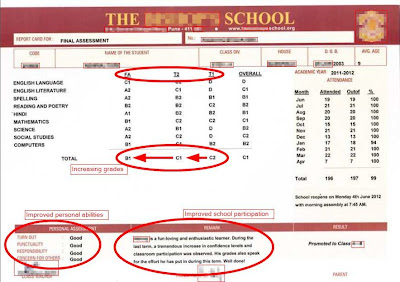 |
| ADHD treatment improves academic performance |
ADHD medication enhances academic performance when started early. ADHD drug treatment improves reading ability in children with Attention Deficit Hyperactivity Disorder (ADHD) and Dyslexia. New research shows that drug treatment of ADHD also improves maths ability especially when started early - at least by the 4th standard. Children starting treatment a year or two later show progressively greater declines in academic performance.
ADHD is characterised by inattention and hyperactive-impulsive behaviour. Parents who bring their children to the clinic are focused only on issues arising from the child's hyperactivity. Impairments due to inattention are not immediately apparent in the pre-school years. Depending on the severity of ADHD, inattention is unmasked when the child enters academic life in primary school or during the transitions to middle school, high school, and college. At each of these stages an increasing demand is placed on the cognitive faculty of attention which the child's brain is not capable of meeting.
Children with ADHD fail to absorb formative academic concepts in primary school. However, rote learning or tutoring by the parents helps the child clear these initial stages. It is only later when the cognitive load exceeds the child's capacity to concentrate that academic problems become manifest. By this time the child's academic progress has already taken a downward trajectory. Reversing this trend and repairing the negative impact on the child's self-esteem entails considerably more effort, time and sustenance at these later stages. The earlier treatment for ADHD is initiated, the better.
Inattention in ADHD is due to altered brain proteins. These are involved in modulation of the neurochemical - dopamine. This results in reduced dopamine in the synapse (fluid filled space that transmits information from one brain cell to another). Altered dopamine modulation in the frontal lobe of the brain makes the child impulsive and distractible. ADHD medications act on dopamine and noradrenaline receptors to keep each dopamine molecule longer in the synaptic cleft. Dopamine is then available to stimulate the receptors for longer.
Parental concerns regarding side-effects of ADHD drug treatment on the developing child are largely unfounded. There is now evidence that shows long-term treatment with therapeutic doses of ADHD medication does not affect the developing brain or other standard measures of growth. ADHD drug treatment also does not increase the risk for addiction. As with any other medication side effects can arise at the start of treatment. Adherence to the review schedule will help monitor and mitigate these. All medication is prescribed after carefully weighing the risks and benefits. In the case of ADHD the risks are poor academic functioning and subsequent narrowing of career options at best, to dropping out or expulsion from school and subsequent delinquency at the worst. The benefits of treatment are highlighted in the report card shown above.
Drug treatment of ADHD enhances academic performance and learning by reducing the inattention and hyperactivity of ADHD. The child with ADHD has attentional and impulse control issues. Inattention and hyperactivity interfere with classroom learning. The earlier ADHD treatment is started the better the outcome in terms of academic achievement. Many children have experienced these benefits.
References
- Kathryn E Gill, Peter J Pierre, James Daunais, Allyson J Bennett, Susan Martelle, H Donald Gage, James M Swanson, Michael A Nader and Linda J Porrino. Chronic Treatment with Extended Release Methylphenidate Does Not Alter Dopamine Systems or Increase Vulnerability for Cocaine Self-Administration: A Study in Nonhuman Primates. Neuropsychopharmacology , (18 July 2012) | doi:10.1038/npp.2012.117
- Penny Corkum, Melissa McGonnell and Russell Schachar. Factors affecting academic achievement in children with ADHD. Journal of Applied Research on Learning. Vol. 3, Article 9, 2010.
- Zoëga, et al. A Population-Based Study of Stimulant Drug Treatment of ADHD and Academic Progress in Children. Pediatrics 2012;130:2011-3493




